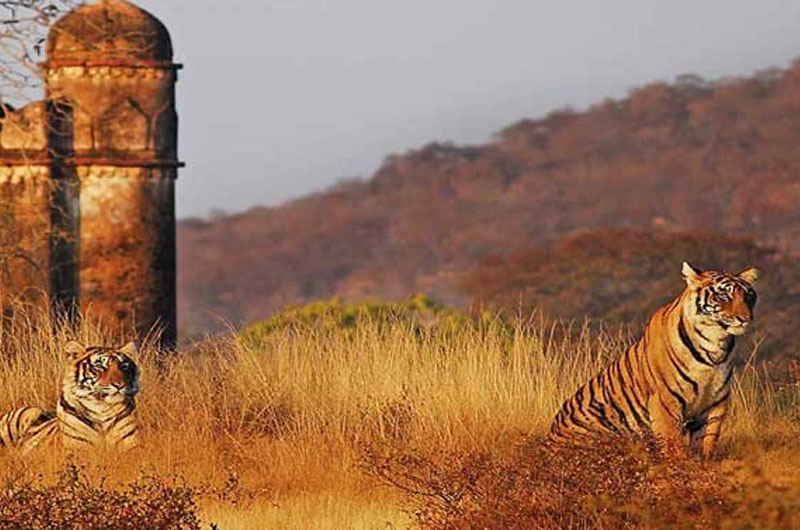
Ranthambore National Park: Where Tigers Roam Free
Ranthambore National Park, located in the Sawai Madhopur district of Rajasthan, India, is one of the largest and most renowned national parks in Northern India. Spread over an area of approximately 392 square kilometers, it is a prominent wildlife sanctuary known for its thriving population of Bengal tigers. The park is a significant part of the Project Tiger initiative and offers a unique blend of history, natural beauty, and biodiversity. This guide provides a detailed overview of Ranthambore National Park, highlighting its specialties, locality, best time to visit, and nearby amenities.
Overview of Ranthambore National Park
Location and Geography
- Locality: Sawai Madhopur district, Rajasthan, India
- Geographical Features:
- Diverse terrain including dry deciduous forests, hills, and lakes
- The park is dotted with ancient ruins, including Ranthambore Fort
- Situated at the junction of the Aravalli and Vindhya hill ranges
Specialty
- Tiger Reserve:
- Home to a significant population of Bengal tigers
- Known for successful tiger conservation efforts and wildlife sightings
- Rich in biodiversity with diverse flora and fauna
Best Time to Visit
- Optimal Seasons: October to April
- Weather Conditions:
- Winter (October to February): Cool and pleasant, ideal for wildlife sightings
- Summer (March to June): Hot, with better chances of tiger sightings near water bodies
- Monsoon (July to September): Park remains closed due to heavy rains
Wildlife and Flora
Fauna
- Mammals:
- Bengal tiger
- Indian leopard
- Sloth bear
- Indian wild boar
- Spotted deer, sambar deer, and nilgai
- Birds:
- Over 300 species including peafowl, owls, eagles, and migratory birds
- Notable sightings of painted storks and Indian paradise flycatcher
- Reptiles and Amphibians:
- Marsh crocodile
- Various species of snakes, lizards, and frogs
Flora
- Vegetation Types:
- Dry deciduous forests with dominant species like dhok and banyan trees
- Open grasslands and scrublands
- Various medicinal plants and herbs
Zones and Activities
Main Zones
- Core Zones (Zones 1 to 5):
- Known for tiger sightings and wildlife photography
- Conducts jeep safaris and canter safaris
- Buffer Zones (Zones 6 to 10):
- Offers a mix of wildlife and cultural experiences
- Includes Ranthambore Fort and ancient temples
Activities
- Jeep Safaris:
- Morning and evening safaris to explore different zones
- Guided by experienced naturalists
- Canter Safaris:
- Larger group safaris ideal for wildlife enthusiasts
- Covers wider areas of the park
- Nature Walks:
- Guided walks through the forests
- Learn about the park’s ecology and conservation efforts
Nearby Restaurants and Hotels
Restaurants
- The Oberoi Vanyavilas:
- Fine dining restaurant offering Indian and international cuisine
- Located near the park entrance
- Ranthambore Forest Resort:
- Multi-cuisine restaurant with a focus on local Rajasthani dishes
- Provides a variety of dining options
Hotels and Lodges
- The Oberoi Vanyavilas:
- Luxury tented accommodations amidst lush gardens
- Offers spa services, wildlife experiences, and safari packages
- Taj Sawai Madhopur Lodge:
- Heritage hotel with traditional Rajasthani architecture
- Provides comfortable rooms, dining options, and safari arrangements
- Ranthambore Kothi:
- Boutique hotel with modern amenities
- Offers personalized service and wildlife safari tours
Conclusion
Ranthambore National Park stands as a prime example of wildlife conservation and eco-tourism in India, offering visitors an opportunity to witness the majestic Bengal tiger in its natural habitat. Whether you are a wildlife enthusiast, a nature photographer, or someone seeking a cultural experience, Ranthambore provides an enriching and memorable journey. Plan your visit during the optimal seasons, and explore the park’s various zones and activities to fully appreciate the natural wonders and wildlife diversity of this iconic sanctuary.
